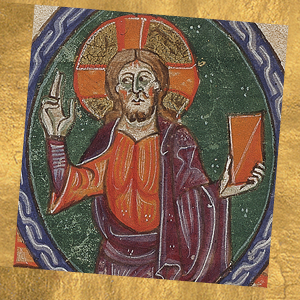St. Sylvester I, Pope

Sylvester, Pope in the Age of Christian Liberty
St. Sylvester was the first Pope of Rome to reign entirely under the liberty of the Church, guaranteed by the Edict of Milan in 313. Sylvester - a priest of Rome and the son of one Rufinus, according to the Liber pontificalis - was elected to the See of Peter in 314. During Sylvester’s reign, the city began its transition into its Christian era, with the construction of the great Constantinian basilicas - including the Basilica of St. Peter on the Vatican Hill, which was erected above a temple dedicated to Apollo, to mark the burial place of the first Bishop of Rome. St. Sylvester and Emperor Constantine also collaborated on the the Lateran Basilica and Baptistery, which were built adjacent to the former imperial palace where the Pontiff lived, as well as the (Roman) Basilica of the Holy Cross in Jerusalem, and the Basilica of St. Paul outside the walls. Sylvester’s memory, however, is most closely tied to the church of St. Martin and Sylvester (known as the titulus Equitii, owing to its building site’s having been donated by a priest, Equitius) which still stands in Rome’s Monti neighborhood.
“Confessor of Faith”
It is uncertain, however, what role Sylvester hade - if any - in the negotiations regarding the Donatists at Arles, or over Arianism at the first Ecumenical Council of Nicea in 325. According to some, he did not even have the opportunity to intervene. What is certain is that his faith so moved his contemporaries, that they publicly honored him as “confessor”, i.e. one who, though not suffering martyrdom, lived a life completely given to Christ. Pope St. Sylvester also contributed to the development of the liturgy. It was most probably during his reign that the first Roman Martyrology was composed, and his name is associated with the creation of the ancient Roman school of sacred song.
Militia Aurata
Pope St. Sylvester is patron of the chivalric order called the Militia Aurata, or “of the Golden Spur”, which, as tradition would have it, was founded by Emperor Constantine I in person. After various events throughout the centuries, in 1841, Pope Gregory XVI, in the framework of a vast reform of the equestrian orders, separated the Order of Pope St. Sylvester from the Militia Aurata, assigning to the Order of St. Sylvester particular statutes and decorations. In 1905, Pope St. Pius X made further amendments, which are still in force. The Order includes four classes: Knight/Dame, Knight/Dame Commander, Knight/Dame Commander with Star (Grand Officer), Knight/Dame Grand Cross.
More upcoming events:







 Your contribution for a great mission
Your contribution for a great mission

